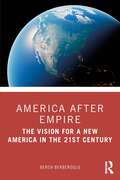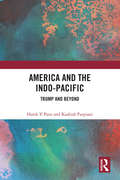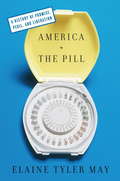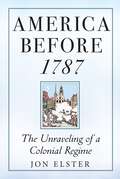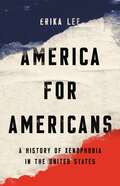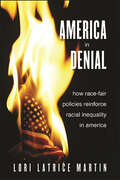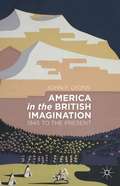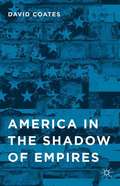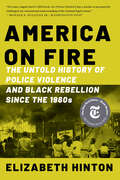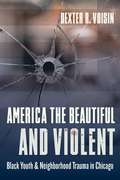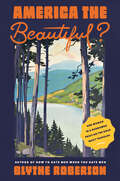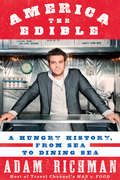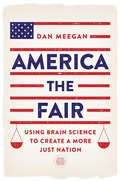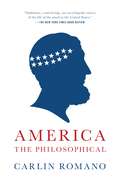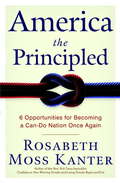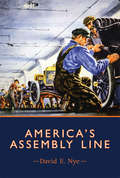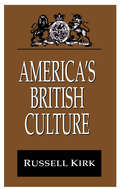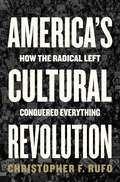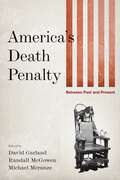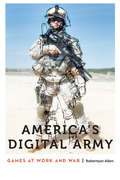- Table View
- List View
America after Empire: The Vision for a New America in the 21st Century
by Berch BerberogluAfter the end of America’s longest (20-year) war in Afghanistan and Iraq that cost more than $6 trillion and nearly half a million lives, what does the future hold for America and the American people in the 21st century? In this timely and important book, Berch Berberoglu provides an eye-opening account of the history of the American Empire from its inception to the present, with prospects for its future. Examining the worldwide expansion of the American Empire over the course of its turbulent history in great detail, Berberoglu assesses America’s imperial legacy in a sober way, highlighting its failure to come to terms with the enormous cost of this adventure in imperial overreach. But Berberoglu sees light at the end of the long, dark tunnel, when the American people will awaken and lead the way to a new America after empire in the coming decades of the 21st century.
America and the Indo-Pacific: Trump and Beyond
by Harsh Pant Kashish ParpianiThis book offers an extensive account of Donald Trump’s foreign policy record in the Indo-Pacific region. Set against the backdrop of Trump’s policy of sustained US confrontation with China, it recounts his administration’s efforts to shore up America’s position with the Indo-Pacific strategy. It also reviews Trump’s record with allies and partners in the Indo-Pacific and the South Asian subregion in context of the ‘great power competition’ between China and the United States. Amidst the ongoing conversations on the declining currency of American internationalism, the volume showcases the seeming insularity of the Indo-Pacific region from forces that are informing an America in retreat. In noting Trump’s record to have been a consequential one, the authors also offer insights into the prospects for US policy continuity under Joe Biden. This timely book will be of great interest to scholars, teachers and students of politics and international relations, Asia studies, US-China studies, area studies, foreign policy, maritime studies, and world politics. It is a recommended read for all watchers of US foreign policy and the evolving US-China rivalry.
America and the Pill: A History of Promise, Peril, and Liberation
by Elaine Tyler MayIn 1960, the FDA approved the contraceptive commonly known as "the pill. ” Advocates, developers, and manufacturers believed that the convenient new drug would put an end to unwanted pregnancy, ensure happy marriages, and even eradicate poverty. But as renowned historian Elaine Tyler May reveals in America and the Pill, it was women who embraced it and created change. They used the pill to challenge the authority of doctors, pharmaceutical companies, and lawmakers. They demonstrated that the pill was about much more than family planning-it offered women control over their bodies and their lives. From little-known accounts of the early years to personal testimonies from young women today, May illuminates what the pill did and did not achieve during its half century on the market.
America as Second Creation: Technology and Narratives of New Beginnings
by David E. NyeAfter 1776, the former American colonies began to reimagine themselves as a unified, self-created community. Technologies had an important role in the resulting national narratives, and a few technologies assumed particular prominence. Among these were the axe, the mill, the canal, the railroad, and the irrigation dam. In this book David Nye explores the stories that clustered around these technologies. In doing so, he rediscovers an American story of origins, with America conceived as a second creation built in harmony with God's first creation. While mainstream Americans constructed technological foundation stories to explain their place in the New World, however, marginalized groups told other stories of destruction and loss. Native Americans protested the loss of their forests, fishermen resisted the construction of dams, and early environmentalists feared the exhaustionof resources. A water mill could be viewed as the kernel of a new community or as a new way to exploit labor. If passengers comprehended railways as part of a larger narrative about American expansion and progress, many farmers attacked railroad land grants. To explore these contradictions, Nye devotes alternating chapters to narratives of second creation and to narratives of those who rejected it. Nye draws on popular literature, speeches, advertisements, paintings, and many other media to create a history of American foundation stories. He shows how these stories were revised periodically, as social and economic conditions changed, without ever erasing the earlier stories entirely. The image of the isolated frontier family carving a homestead out of the wilderness with an axe persists to this day, alongside later images and narratives. In the book's conclusion, Nye considers the relation between these earlier stories and such later American developments as the conservation movement, narratives of environmental recovery, and the idealization of wilderness.
America before 1787: The Unraveling of a Colonial Regime
by Jon ElsterAn original account, drawing on both history and social science, of the causes and consequences of the American RevolutionWith America before 1787, Jon Elster offers the second volume of a projected trilogy that examines the emergence of constitutional politics in France and America. Here, he explores the increasingly uneasy relations between Britain and its American colonies and the social movements through which the thirteen colonies overcame their seemingly deep internal antagonisms.Elster documents the importance of the radical uncertainty about their opponents that characterized both British and American elites and reveals the often neglected force of enthusiasm, and of emotions more generally, in shaping beliefs and in motivating actions. He provides the first detailed examinations of &“divide and rule&” as a strategy used on both sides of the Atlantic and of the rise and fall of collective action movements among the Americans. Elster also explains how the gradual undermining in America of the British imperial system took its toll on transatlantic relations and describes how state governments and the American Confederation made crucial institutional decisions that informed and constrained the making of the Constitution.Drawing on a wide range of historical sources and on theories of modern social science, Elster brings together two fields of scholarship in innovative and original ways. The result is a unique synthesis that yields new insights into some of the most important events in modern history.
America for Americans: A History of Xenophobia in the United States
by Erika LeeAn award-winning historian reframes our continuing debate over immigration with a compelling history of xenophobia in the United States and its devastating impactThe United States is known as a nation of immigrants. But it is also a nation of xenophobia. In America for Americans, Erika Lee shows that an irrational fear, hatred, and hostility toward immigrants has been a defining feature of our nation from the colonial era to the Trump era. Benjamin Franklin ridiculed Germans for their "strange and foreign ways." Americans' anxiety over Irish Catholics turned xenophobia into a national political movement. Chinese immigrants were excluded, Japanese incarcerated, and Mexicans deported. Today, Americans fear Muslims, Latinos, and the so-called browning of America. Forcing us to confront this history, America for Americans explains how xenophobia works, why it has endured, and how it threatens America. It is a necessary corrective and spur to action for any concerned citizen.
America in An Arab Mirror: Images of America in Arabic Travel Literature: An Anthology
by K. Abdel-MalekThis distinguished anthology presents for the first time in English travel essays by Arabic writers who have visited America in the second half of the century. The view of America which emerges from these accounts is at once fascinating and illuminating, but never monolithic. The writers hail from a variety of viewpoints, regions, and backgrounds, so their descriptions of America differently engage and revise Arab pre-conceptions of Americans and the West. The country figures as everything from the unchanging Other, the very antithesis of the Arab self, to the seductive female, to the Other who is both praiseworthy and reprehensible.
America in Denial: How Race-Fair Policies Reinforce Racial Inequality in America (SUNY series in African American Studies)
by Lori Latrice MartinIn America in Denial Lori Latrice Martin examines the myth of a race-fair America by reviewing and offering alternatives to universal, race-neutral programs and policies as well as other allegedly race-neutral initiates. By considering policies and programs related to wealth, health, education, and criminal justice, while presenting themselves as race-neutral, Martin reveals that black scholars and politicians, in particular, seemingly capitulate and have become proponents of these programs and policies that perpetuate the myth of a race-fair America. This (mis)use provides cover for elected officials and presidential hopefuls needed to garner the support and authenticity required to increase public support for their initiatives. These issues must be unpacked and debunked, and the material and nonmaterial harm historically done to black people, and still felt today, must be acknowledged. The idea that programs available to all people will benefit black people is demonstratively untrue, and the alternatives presented in America in Denial will generate much-needed conversations.
America in the British Imagination
by John F. LyonsHow was American culture disseminated into Britain? Why did many British citizens embrace American customs? And what picture did they form of American society and politics? This engaging and wide-ranging history explores these and other questions about the U. S. 's cultural and political influence on British society in the post-World War II period.
America in the Shadow of Empires
by David CoatesThe focus of the book is the cost of empire, particularly the cost in the American case the internal burden of American global leadership. The book builds an argument about the propensity of external responsibilities to undermine the internal strength, raising the question of the link between weakening and the global spread of American power. "
America in the Time of Martin Luther King Jr. (1948-1976)
by Sally Senzell IsaacsAmerica in the Time of is a series of nine books arranged chronologically, meaning that events are described in the order in which they happened. In each book, most articles deal with a particular event or part of American history. This book is about America from 1948 to 1976.
America in the Twenties: A History
by Geoffrey PerretEveryone knows the Twenties: flappers, jazz bands, the Charleston, teacups filled with bathtub gin-one long party and everyone had a hangover (known as the Depression) in the morning. The Twenties are both the most derided decade in American history and the most glamorous. It has been a pleasant experience to be told "How interesting" when people wanted to know what I was writing. They often elaborated with remarks such as "What a wonderfully decadent time!" or "That was the last time Americans really knew how to enjoy themselves." Almost without exception the hundred or more people who've asked me about this book had a firm, unshakable idea of what the period was like. I had begun with much the same idea myself. I thought of the Twenties as a period that had been "done"-to a turn.
America on Fire: The Untold History Of Police Violence And Black Rebellion Since The 1960s
by Elizabeth HintonFrom one of our top historians, a groundbreaking story of policing and “riots” that shatters our understanding of the post–civil rights era. <P><P> What began in spring 2020 as local protests in response to the killing of George Floyd by Minneapolis police quickly exploded into a massive nationwide movement. Millions of mostly young people defiantly flooded into the nation’s streets, demanding an end to police brutality and to the broader, systemic repression of Black people and other people of color. To many observers, the protests appeared to be without precedent in their scale and persistence. Yet, as the acclaimed historian Elizabeth Hinton demonstrates in America on Fire, the events of 2020 had clear precursors—and any attempt to understand our current crisis requires a reckoning with the recent past. <P><P>Even in the aftermath of Donald Trump, many Americans consider the decades since the civil rights movement in the mid-1960s as a story of progress toward greater inclusiveness and equality. Hinton’s sweeping narrative uncovers an altogether different history, taking us on a troubling journey from Detroit in 1967 and Miami in 1980 to Los Angeles in 1992 and beyond to chart the persistence of structural racism and one of its primary consequences, the so-called urban riot. Hinton offers a critical corrective: the word riot was nothing less than a racist trope applied to events that can only be properly understood as rebellions—explosions of collective resistance to an unequal and violent order. As she suggests, if rebellion and the conditions that precipitated it never disappeared, the optimistic story of a post–Jim Crow United States no longer holds. <P><P>Black rebellion, America on Fire powerfully illustrates, was born in response to poverty and exclusion, but most immediately in reaction to police violence. In 1968, President Lyndon Johnson launched the “War on Crime,” sending militarized police forces into impoverished Black neighborhoods. Facing increasing surveillance and brutality, residents threw rocks and Molotov cocktails at officers, plundered local businesses, and vandalized exploitative institutions. Hinton draws on exclusive sources to uncover a previously hidden geography of violence in smaller American cities, from York, Pennsylvania, to Cairo, Illinois, to Stockton, California. <P><P>The central lesson from these eruptions—that police violence invariably leads to community violence—continues to escape policymakers, who respond by further criminalizing entire groups instead of addressing underlying socioeconomic causes. The results are the hugely expanded policing and prison regimes that shape the lives of so many Americans today. Presenting a new framework for understanding our nation’s enduring strife, America on Fire is also a warning: rebellions will surely continue unless police are no longer called on to manage the consequences of dismal conditions beyond their control, and until an oppressive system is finally remade on the principles of justice and equality.
America the Beautiful and Violent: Black Youth and Neighborhood Trauma in Chicago
by Dexter VoisinWidespread media narratives portray an epidemic of neighborhood violence in urban areas—often ignoring the structural explanations advanced by community organizers fighting violence and activists such as those in the Movement for Black Lives. In this book, Dexter R. Voisin provides a compelling and social-justice-oriented analysis of current trends in neighborhood violence in light of the historical and structural factors that have reproduced entrenched patterns of racial and economic inequality. <P><P>America the Beautiful and Violent is built around the powerful voices and insights of black youth in Chicago and their parents and communities. Voisin interweaves their narratives with data, research findings, and historical accounts that provide context for their experiences. He highlights the broad historical, political, economic, and racial factors that shape the construction, concentration, and narratives of violence in black neighborhoods. Voisin explores these forces and the violence they produce; the behavioral health consequences of repeated exposures to neighborhood violence; and the ways youth, families, and communities cope with such traumas. America the Beautiful and Violent offers a set of practice and policy recommendations to address the patchwork inequality that leads to concentrated violence and to support children and adolescents struggling with the precarious conditions and threat of violence in their daily lives.
America the Beautiful?: One Woman in a Borrowed Prius on the Road Most Traveled
by Blythe RobersonThe author of How to Date Men When You Hate Men examines Americans’ obsession with freedom, travel, and the open road in this funny, entertaining travelogue that blends the humorous observations of Bill Bryson with the piercing cultural commentary of Jia Tolentino.For writer and comedian Blythe Roberson, there are only so many Mary Oliver poems you can read about being free, and only so many times you can listen to Joni Mitchell’s travel album Hejira, before you too, are itching to take off. Canonical American travel writers have long celebrated the road trip as the epitome of freedom. But why does it seem like all those canonical travel narratives are written by white men who have no problems, who only decide to go the desert to see what having problems feels like?To fill in the literary gaps and quench her own sense of adventure, Roberson quits her day job and sets off on a Great American Road Trip to visit America’s national parks.America the Beautiful? is a hilarious trip into the mind of one of the Millennial generation’s funniest writers. Borrowing her Midwestern stepfather’s Prius, she heads west to the Loop of mega-popular parks, over to the ocean and down the Pacific Coast Highway, and, in a feat of spectacularly bad timing, through the southwestern desert in the middle of July. Along the way she meets new friends on their own personal quests, learns to cope with abstinence while missing the comforts of home, and comes to understand the limits—and possibilities—of going to nature to prove to yourself and your Instagram followers that you are, in fact, free.The result is a laugh-out-loud-while-occasionally-raging-inside travelogue, filled with meditations and many, many jokes on ecotourism, conservation, freedom, traffic, climate change, and the structural and financial inequalities that limit so many Americans’ movement. Ultimately, Roberson ponders the question: Is quitting society and going on the road about enlightenment and liberty—or is it just selfish escapism?
America the Edible: A Hungry History, from Sea to Dining Sea
by Adam RichmanGet ready to devour America. Adam Richman, the exuberant host of Travel Channel's Man v. Food and Man v. Food Nation, has made it his business to root out unique dining experiences from coast to coast. Now, he zeroes in on some of his top-favorite cities—from Portland, Maine, to Savannah, Georgia—to share his uproariously entertaining food travel stories, top finds, and some invaluable (and hilarious) cautionary tales. America the Edible also tells the story behind the menu, revealing the little-known reason why San Francisco's sourdough bread couldn't exist without San Francisco's fog; why Cleveland just might have some of the country's best Asian cuisine; and how to eat like a native on the Hawaiian island of Oahu. Unflaggingly funny, curious, and, of course, hungry, Richman captures the spectacular melting pot of American cuisine as only a true foodie and insatiable storyteller can.
America the Fair: Using Brain Science to Create a More Just Nation
by Dan MeeganWhat makes a person liberal or conservative? Why does the Democratic Party scare off so many possible supporters? When does our "injustice trigger" get pulled, and how can fairness overcome our human need to look for a zero-sum outcome to our political battles?Tapping into a pop culture zeitgeist linking Bugs Bunny, Taylor Swift, and John Belushi; through popular science and the human brain; to our political predilections, arguments, and distrusts, Daniel Meegan suggests that fairness and equality are key elements missing in today's society. Having crossed the border to take up residency in Canada, Meegan, an American citizen, has seen first-hand how people enjoy as rights what Americans view as privileges. Fascinated with this tension, he suggests that American liberals are just missing the point. If progressives want to win the vote, they need to change strategy completely and champion government benefits for everyone, not just those of lower income. If everyone has access to inexpensive quality health care, open and extensive parental leave, and free postsecondary education, then everyone will be happier and society will be fair. The Left will also overcome an argument of the Right that successfully, though incongruously, appeals to the middle- and upper-middle classes: that policies that help the economically disadvantaged are inherently bad for others. Making society fair and equal, Meegan argues, would strengthen the moral and political position of the Democratic Party and place it in a position to revive American civic life. Fairness, he writes, should be selfishly enjoyed by everyone.
America the Philosophical
by Carlin RomanoA bold, insightful book that rejects the myth of America the Unphilosophical, arguing that America today towers as the most philosophical culture in the history of the world, an unprecedented marketplace of truth and argument that far surpasses ancient Greece or any other place one can name. With verve and keen intelligence, Carlin Romano--Pulitzer Prize finalist, award-winning book critic, and professor of philosophy--takes on the widely held belief that ours is an anti-intellectual society. Instead, while providing a richly reported overview of American thought, Romano argues that ordinary Americans see through phony philosophical justifications faster than anyone else, and that the best of our thinkers abandon artificial academic debates for fresh intellectual enterprises, such as cyberphilosophy. Along the way, Romano seeks to topple philosophy's most fiercely admired hero, Socrates, asserting that it is Isocrates, the nearly forgotten Greek philosopher who rejected certainty, whom Americans should honor as their intellectual ancestor. America the Philosophical introduces readers to a nation whose existence most still doubt: a dynamic, deeply stimulating network of people and places drawn together by shared excitement about ideas. From the annual conference of the American Philosophical Association, where scholars tack wiseguy notes addressed to Spinoza on a public bulletin board, to the eruption of philosophy blogs where participants discuss everything from pedagogy to the philosophy of science to the nature of agency and free will, Romano reveals a world where public debate and intellectual engagement never stop. And readers meet the men and women whose ideas have helped shape American life over the previous few centuries, from well-known historical figures like William James and Ralph Waldo Emerson, to modern cultural critics who deserve to be seen as thinkers (Kenneth Burke, Edward Said), to the iconoclastic African American, women, Native American, and gay mavericks (Cornel West, Susan Sontag, Anne Waters, Richard Mohr) who have broadened the boundaries of American philosophy. Smart and provocative, America the Philosophical is a rebellious tour de force that both celebrates our country's unparalleled intellectual energy and promises to bury some of our most hidebound cultural clichés.
America the Principled
by Rosabeth Moss KanterKanter details six ways to restore America's strengths by returning to open-society principles, viewing this society as one that "invests in people and new ideas, rewards talent and hard work, values dialogue and learns from dissent, operates to high standards with transparent information, looks for common ground, sees problems as opportunities for creative change, and encourages those who are fortunate to help others. " She discusses how America needs to spread innovation and the opportunity to participate in the economic revolution of the twenty-first century, and have a new social contract based on real family values and fair and flexible workplaces attentive to families and women. She also argues for values-based capitalism and responsible companies, government as an instrument of public interest, engagement with the world and other countries, and a community of caring. Kanter (strategy, innovation, and leadership for change, Harvard Business School) has advised CEOs of large and small companies and is the author of several books. Annotation ©2008 Book News, Inc. , Portland, OR (booknews. com)
America's Asia: Racial Form and American Literature, 1893-1945
by Colleen LyeWhat explains the perception of Asians both as economic exemplars and as threats? America's Asia explores a discursive tradition that affiliates the East with modern efficiency, in contrast to more familiar primitivist forms of Orientalism. Colleen Lye traces the American stereotype of Asians as a "model minority" or a "yellow peril"--two aspects of what she calls "Asiatic racial form"-- to emergent responses to globalization beginning in California in the late nineteenth century, when industrialization proceeded in tandem with the nation's neocolonial expansion beyond its continental frontier. From Progressive efforts to regulate corporate monopoly to New Deal contentions with the crisis of the Great Depression, a particular racial mode of social redress explains why turn-of-the-century radicals and reformers united around Asian exclusion and why Japanese American internment during World War II was a liberal initiative. In Lye's reconstructed archive of Asian American racialization, literary naturalism and its conventions of representing capitalist abstraction provide key historiographical evidence. Arguing for the profound influence of literature on policymaking, America's Asia examines the relationship between Jack London and leading Progressive George Kennan on U.S.-Japan relations, Frank Norris and AFL leader Samuel Gompers on cheap immigrant labor, Pearl S. Buck and journalist Edgar Snow on the Popular Front in China, and John Steinbeck and left intellectual Carey McWilliams on Japanese American internment. Lye's materialist approach to the construction of race succeeds in locating racialization as part of a wider ideological pattern and in distinguishing between its different, and sometimes opposing, historical effects.
America's Assembly Line
by David E. NyeFrom the Model T to today's "lean manufacturing": the assembly line as crucial, yet controversial, agent of social and economic transformation.The mechanized assembly line was invented in 1913 and has been in continuous operation ever since. It is the most familiar form of mass production. Both praised as a boon to workers and condemned for exploiting them, it has been celebrated and satirized. (We can still picture Chaplin's little tramp trying to keep up with a factory conveyor belt.) In America's Assembly Line, David Nye examines the industrial innovation that made the United States productive and wealthy in the twentieth century.The assembly line—developed at the Ford Motor Company in 1913 for the mass production of Model Ts—first created and then served an expanding mass market. It also transformed industrial labor. By 1980, Japan had reinvented the assembly line as a system of “lean manufacturing”; American industry reluctantly adopted the new approach. Nye describes this evolution and the new global landscape of increasingly automated factories, with fewer industrial jobs in America and questionable working conditions in developing countries. A century after Ford's pioneering innovation, the assembly line continues to evolve toward more sustainable manufacturing.
America's British Culture (The\library Of Conservative Thought Ser.)
by Russell KirkIt is an incontestable fact of history that the United States, although a multiethnic nation, derives its language, mores, political purposes, and institutions from Great Britain. The two nations share a common history, religious heritage, pattern of law and politics, and a body of great literature. Yet, America cannot be wholly confident that this heritage will endure forever. Declining standards in education and the strident claims of multiculturalists threaten to sever the vital Anglo-American link that ensures cultural order and continuity. In "America's British Culture", now in paperback, Russell Kirk offers a brilliant summary account and spirited defense of the culture that the people of the United States have inherited from Great Britain. Kirk discerns four essential areas of influence. The language and literature of England carried with it a tradition of liberty and order as well as certain assumptions about the human condition and ethical conduct. American common and positive law, being derived from English law, gives fuller protection to the individual than does the legal system of any other country. The American form of representative government is patterned on the English parliamentary system. Finally, there is the body of mores - moral habits, beliefs, conventions, customs - that compose an ethical heritage. Elegantly written and deeply learned, "America's British Culture" is an insightful inquiry into history and a plea for cultural renewal and continuity. Adam De Vore in "The Michigan Review" said of the book: "A compact but stimulating tract...a contribution to an over-due cultural renewal and reinvigoration...Kirk evinces an increasingly uncommon reverence for historical accuracy, academic integrity and the understanding of one's cultural heritage," and Merrie Cave in "The Salisbury Review" said of the author: "Russell Kirk has been one of the most important influences in the revival of American conservatism since the fifties. [Kirk] belongs to an
America's Cultural Revolution: How the Radical Left Conquered Everything
by Christopher F. RufoAN INSTANT NEW YORK TIMES, USA TODAY, AND AMAZON BESTSELLER America’s most effective conservative intellectual proves once and for all that Marxist radicals have taken over our nation's institutions.In the 1960s, Mao launched China’s Cultural Revolution. Cities grew overcrowded. Technocrats demanded progress from above. Anyone opposed was sent to be “re-educated.” China’s revolution was bloody, fast, and a failure, but what if America started a revolution at the same time, based on the same bad ideas, and it’s just been slower, calmer, and more effective?In his powerful new book, Christopher F. Rufo uncovers the hidden history of left-wing intellectuals and activists who systematically took control of America’s institutions to undermine them from within. America’s Cultural Revolution finally answers so many of the questions normal Americans have, such as:• Why is nearly every major corporation bending the knee to a far-left agenda?• How did DEI suddenly become the department no institution can continue without?• Why is race the main thing America’s rich, white elite wants to talk about? • When did the left adopt all this doublespeak, saying progress is a lack of progress, equality is not equality, speech is violence, and violence is speech?• Has the goal of the left, for a century, actually been the destruction of every Western institution? Readers may not know the names of Herbert Marcuse, Angela Davis, Paulo Freire, and Derrick Bell, but they will recognize the ideas they spread. How their radical, destructive ideology slowly worked its way from prisons to academia to classrooms to your human resources department will come as a shock.Failing to act soon, Rufo warns, could allow the radical left to achieve their ultimate objective: replacing constitutional equality with a race-based redistribution system overseen by bureaucratic ‘diversity and inclusion’ officials. Most Americans don’t want this, but most Americans are no longer in control of our institutions. If the mainstream media’s depiction of a failing dystopia in need of a fresh start never sounded right to you, this expose and call to arms is the book you’ve been looking for.
America's Death Penalty: Between Past and Present
by David Garland Michael Meranze Randall McGowenOver the past three decades, the United States has embraced the death penalty with tenacious enthusiasm. While most of those countries whose legal systems and cultures are normally compared to the United States have abolished capital punishment, the United States continues to employ this ultimate tool of punishment. The death penalty has achieved an unparalleled prominence in our public life and left an indelible imprint on our politics and culture. It has also provoked intense scholarly debate, much of it devoted to explaining the roots of American exceptionalism.America’s Death Penalty takes a different approach to the issue by examining the historical and theoretical assumptions that have underpinned the discussion of capital punishment in the United States today. At various times the death penalty has been portrayed as an anachronism, an inheritance, or an innovation, with little reflection on the consequences that flow from the choice of words. This volume represents an effort to restore the sense of capital punishment as a question caught up in history. Edited by leading scholars of crime and justice, these original essays pursue different strategies for unsettling the usual terms of the debate. In particular, the authors use comparative and historical investigations of both Europe and America in order to cast fresh light on familiar questions about the meaning of capital punishment. This volume is essential reading for understanding the death penalty in America.Contributors: David Garland, Douglas Hay, Randall McGowen, Michael Meranze, Rebecca McLennan, and Jonathan Simon.
America's Digital Army: Games at Work and War (Anthropology of Contemporary North America)
by Robertson AllenAmerica’s Digital Army is an ethnographic study of the link between interactive entertainment and military power, drawing on Robertson Allen’s fieldwork observing video game developers, military strategists, U.S. Army marketing agencies, and an array of defense contracting companies that worked to produce the official U.S. Army video game, America’s Army. Allen uncovers the methods by which gaming technologies such as America’s Army, with military funding and themes, engage in a militarization of American society that constructs everyone, even nonplayers of games, as virtual soldiers available for deployment.America’s Digital Army examines the army’s desire for “talented” soldiers capable of high-tech work; beliefs about America’s enemies as reflected in the game’s virtual combatants; tensions over best practices in military recruiting; and the sometimes overlapping cultures of gamers, game developers, and soldiers. Allen reveals how binary categorizations such as soldier versus civilian, war versus game, work versus play, and virtual versus real become blurred—if not broken down entirely—through games and interactive media that reflect the U.S. military’s ludic imagination of future wars, enemies, and soldiers.
